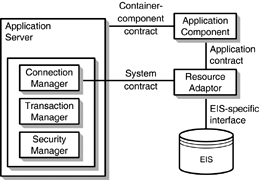What Is J2EE Connector Architecture (J2CA)?
| J2CA provides a standard for connecting J2EE application servers with heterogeneous Enterprise Information Systems (EISs) such as Customer Relationship Management (CRM), Supply Chain Management (SCM), mainframe transaction processing systems, database systems, and legacy systems. Broadly speaking, the J2CA specification
The J2CA specification leverages core application server services such as transaction management, connection pooling, and security. Figure 35.1. The J2EE Connector Architecture. Resource AdapterA resource adapter is a system-level software driver that is used by an application server or an application client to connect to an EIS. A resource adapter is also referred to as a J2CA adapter . A resource adapter is specific to an underlying EIS. There are three kinds of system-level contracts, as described in the following sections. Connection Management ContractThe connection management contract provides a consistent programming model for connection acquisition for both managed and nonmanaged (two- tier ) applications. It enables a resource adapter to provide a connection factory and connection interfaces. It provides a generic mechanism by which an application server can provide different Quality of Services (QoS) ”transactions, advanced pooling, security, logging, and so on ”for its configured set of resource adapters. It provides support for connection pooling. An application server uses a connection management contract to implement a connection pooling mechanism in its own implementation-specific way. Transaction Management ContractThe transaction management contract is between the application server and the EIS resource manager. A resource manager can support two types of transactions:
Security Management ContractThe security management contract between the application server and the resource adapter extends the connection management contract by adding security-specific details. The security management contract supports EIS sign-on by
Common Client Interface (CCI)The J2EE Connector Architecture also defines a common client interface (CCI) for client applications. It can be used by client applications, including the Enterprise Application Integration (EAI) frameworks, to interact with the EIS using a common client API. A J2CA resource adapter is not required to support the CCI layer. In general, the CCI APIs are composed of APIs for establishing a connection to the EIS, executing EIS commands, encapsulating the query results from EIS, and querying EIS metadata. The current J2CA (1.0) specification does not support the concept of an EIS-initiated event and asynchronous communications in general. The proposed final draft of the new J2CA specification (1.5) focuses on system-level issues such as bidirectional connectivity, message inflow, and life-cycle management, among others. The system contracts now support bidirectional connectivity between the application server and the EIS through the resource adapter. A contract is proposed; that contract needs to exist between the application server and the resource adapter such that the resource adapter can asynchronously deliver messages to different message endpoints in the application server. A resource adapter can thus be used by the application server for both inbound and outbound messages from and to the EIS. A contract between the application server and resource adapter is proposed to allow the application server to manage the life cycle of the resource adapter. This provides a mechanism for the application server to bootstrap a resource adapter during its deployment. |
EAN: 2147483647
Pages: 360
